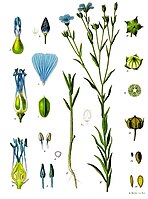
Photo from wikipedia
Abstract Flax (Linum usitatissinum L.) is an economically important fiber crop species as it produces long cellulosic fibers with high tensile strength. The first step in flax fiber extraction occurs… Click to show full abstract
Abstract Flax (Linum usitatissinum L.) is an economically important fiber crop species as it produces long cellulosic fibers with high tensile strength. The first step in flax fiber extraction occurs after harvest via a process known as dew retting in which pulled (uprooted) plants are placed on the soil. During this process microorganisms from the soil and the phyllosphere develop on the plants, leading to partial decomposition of the stem tissues and facilitated mechanical extraction and improved fiber quality. Despite its importance, the management of dew retting is mainly based on empirical knowledge that makes the process difficult to control. In this study the dynamics of flax dew retting were investigated for the first time by combining targeted-metagenomics (metabarcoding), enzymatic activities and chemical and microscopic characterization of the stem. This multimodal approach indicated that intensive microbial colonization and major chemical changes in the stem cell wall composition occurred during the first weeks of retting leading to progressive fiber bundle decohesion in the outer stem tissues. The main changes could be explained by the degradation of pectin-rich and non-lignified thin walls of both the parenchyma cells surrounding fiber bundles, and the differentiating xylem and cambial cells. Field emission scanning electron microscopy suggested that the ultrastructure of the fiber secondary wall is weakly impacted by dew-retting. Analyses indicated that the mechanical properties of extracted technical fibers were improved during the last retting stages. Overall data on thermoplastic composites produced by a twin-screw extrusion and injection molding processes suggested that the retting degree had a small but significant effect on tensile properties.
Journal Title: Industrial Crops and Products
Year Published: 2020
Link to full text (if available)
Share on Social Media: Sign Up to like & get
recommendations!